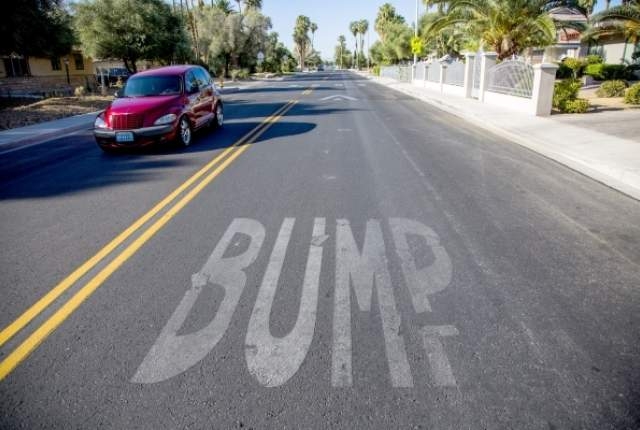There’s a process for getting ‘traffic calmer’ to a neighborhood near you

There’s a big risk in having an adult conversation about traffic calming because there’s always someone in the back of the class giggling about “speed bumps” and “speed humps.”
But we’re going forward — not at full speed, mind you, but forward.
Two readers had inquiries relating to bumps and humps. From Warrior reader Geoffrey:
“Is it my imagination or has there been a shift in labeling speed bumps on our roads? It used to be that I’d see BUMP in large letters warning me, but more and more now I see HUMP. What’s going on? Have the Grammar Police infiltrated NDOT? And what is the difference between a hump and a bump, at least on the roads?”
First off, Geoffrey, don’t blame NDOT. The Nevada Department of Transportation has no bumps or humps on any of its streets and roads. Unless you count the occasional pothole, but that’s another issue.
Clark County also doesn’t acknowledge bumps or humps. So city hall is where most of the bump and hump conversations occur.
Keith Paul, a spokesman for Henderson, said there’s a big difference between humps and bumps.
“While it may seem like semantics, there is a difference between a speed hump and a speed bump,” he said. “Speed humps are engineered for a specific speed, typically 15-20 mph. A vehicle traveling at that speed should be able to travel over the hump without braking significantly. They are generally 3-4 inches high and 12 feet long in the direction of travel. This length reduces the chance of a typical vehicle bottoming out on the hump.”
Speed bumps, on the other hand, don’t follow an engineered design and are typically shorter in length, he said. That results in a more abrupt transition.
Las Vegas spokesman Jace Radke said speed humps are raised “bumps” placed across residential streets. They are designed to calm traffic in residential areas and near parks and schools. The city began constructing speed humps in 1995 in response to neighborhood speeding problems.
Radke said there are drawbacks to speed humps.
“Aside from the inconvenience of construction, some people prefer not to have speed humps placed near their driveways,” he said. “Some worry that motorists will steer onto sidewalks or yards to avoid the humps. Others fear that those speeding over the humps will be noisy or the humps will devalue their homes.”
He said that because of engineering studies that must be completed for each street, speed humps are expensive and only installed after approval by the City Council. Some neighborhoods that qualify for speed humps must wait a long time because limited funds are allocated each year for neighborhood traffic management.
To qualify for a speed hump, a street must carry at least 800 vehicles a day, be mainly residential or have a park or school on it and have a speed limit of 25 mph. Also, it can’t be along a Regional Transportation Commission of Southern Nevada bus route or designated emergency response route.
Any citizen or neighborhood association may request consideration for installation of speed humps by submitting a written petition with signatures from residents of at least 10 homes along that street.
Once the city’s Traffic Engineering Division receives the request, a traffic count is taken. Crews set up equipment to measure how many cars use the road each day. After the traffic study, the Public Works staff will contact a neighborhood representative with the results.
“Keeping pace with traffic activities in one of the fastest-growing cities in the country poses challenges for the Public Works staff,” Radke said. “While it is our aim to provide you with the best service possible, there may be times when we may not respond to your requests as quickly as we’d like to. Please be patient. We will do our best to provide you with a response in as timely a manner as possible.”
And that brings us to Warrior reader Joseph and his desire to get rid of the speed humps in his neighborhood.
“Given the recent articles relative to speed bumps and humps where the city is forcing malls to remove the bumps and humps I am curious as to why Jo Marcy Drive remains untouched.
“Jo Marcy is a city street in the northwest running between Tule Springs and Cimarron roads. Although only four-tenths of a mile long, it contains five speed bumps that require the driver to practically come to a complete stop to get over each one. Seems like a double standard to me. Are there any plans to remove these?”
At the moment, there aren’t any plans to remove them.
In August, colleague James DeHaven did a thorough examination of policy and politics involving humps and bumps. In his report, he noted that the emphasis is more on turning bumps into humps instead of removing them from city streets.
It takes 10 signatures from homeowners along a street to request installation of humps. A written petition to remove humps should be addressed to the Traffic Engineer, City of Las Vegas, 333 N. Rancho Drive, Las Vegas 89106 or call 702-229-6327.
Questions and comments should be sent to roadwarrior@reviewjournal.com. Please include your phone number. Find the Road Warrior on Twitter: @RJroadwarrior